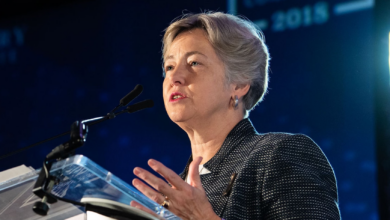
Op-ed: I Will No Longer Hide Like My Teachers Did
by Felicia Martin

Photo: Courtesy Felicia Martin
I was born gay. I came bursting onto the scene in 1977 at St. Joseph Hospital in downtown Houston—a bona fide city girl from day one. And not just any city. Houston is my city—a place that I felt attached to from the moment I could understand that we said the Texas pledge and the Pledge of Allegiance in school every day, and where Mayor Kathy Whitmire was the woman I thought I’d like to be when I grew up. But even though I am as Houstonian as anyone can be, there were many times when I had to look to other places to find acceptance and learn to be who I was.
I grew up on Houston’s north side, attending schools in Aldine for most of my life. I knew that I wasn’t like most of my girly counterparts in school. I had no interest in boys, or boy bands. The only time the word boy came up around me was when someone in my family was accusing me of being a tomboy, which was actually something I embraced. It was difficult, because I didn’t see many other little girls like me, and I longed to find peers and adults in my world who might be able to “get” me in a way that seemed genuine.

Photo: Courtesy Felicia Martin
In the sixth grade, I remember having a basketball coach who rode to school with my history teacher every day. They were both women, and the nature of their relationship was never publically disclosed. However, one day I was asked to grab something from one of their purses, and I noticed a picture of them together. It was clear that they were together-together. It blew my slowly developing mind that two women—two of my favorite women—could actually be in a relationship with one another, and no one knew about it. What was also very clear to me is that they could never let anyone know. This relationship that they had was a secret, and I would do well to stay quiet about it.
I remember walking down the hallway of my high school years ago, for a reunion, and saying something to the effect of, “I don’t remember having many gay teachers when I was here,” and a friend of mine saying, “You probably had more than you knew.” Just the idea of that self-imposed secrecy made me sad. To think about all of the events—football games, dances, fundraisers—where many of my teachers felt free to bring husbands or wives, but not those who were in same-sex relationships, either because of policies that prohibited it, or for fear of being judged, ridiculed, or losing their job. And being fired is a true threat; there is still no federal mandate barring employment discrimination on the basis of sexual identity or gender expression. Teachers can be legally fired for being gay, lesbian, bisexual or transgender in states like Texas. I never saw “ally” stickers on the doors of teachers and counselors in the early ’90s. There seemed to be no safety net, no gentle place where an LGBTQ young person could find “acceptance” rather than mere “tolerance.” For this reason, I wasn’t “out” in my teens. I hid the parts of myself that would not be accepted. I hid from my friends, my family, and myself as I found ways to fit into a high school experience built for some, and not others. I hid like my teachers did.
By the time I made it to Rice in 1995, I was ready to turn over a new leaf. I understood that I was now in a place where I could redefine who I was and start anew. It was in college that I developed my new voice and thought more about how I wanted to operate in the world. I wasn’t a victim, and I didn’t need to come out of some shameful, shady closet. I needed to determine how I might welcome others in.
In some ways, it has taken me up until these last few years in my 30s to welcome in certain family members and friends. But I did make a commitment in my early 20s that I would not be silent about my sexuality in the workplace. Indeed, the memory of my two sixth-grade teachers in hiding made me cringe at the idea of having to hide who I was. And interestingly enough, I chose to work in education. Since then, I have been open and transparent to my supervisors and peers about my truth, what I value, and how I want those things to be integrated into my work with students.
Unfortunately, I don’t think my professional approach is realistic for all of my LGBTQ colleagues in the public school system. There has to be more movement toward protections for our emerging LGBTQ teaching corps, as well as those veteran teachers who have been hiding in their classrooms for years. This is the purpose of an upcoming panel discussion that I will be a part of, entitled “The State of Education in LGBTQ America.” It is being held on Monday, November 24, 6:30–8 p.m. at the Montrose Center.
I want to encourage the young people I work with to live their lives openly, and to consider teaching as one of the most important professions we have in this country. I want them to know that all of our children would be better served if they decided to take on that role, confidently and courageously.
What: Teach for America’s “The State of Education in LGBTQ America” panel
When: November 24, 6:30-8 p.m.
Where: The Montrose Center, 401 Branard St.
Details: http://on.fb.me/1wYr3Jl










